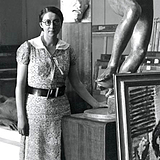Important dates
-
November 1, 1898: Birth in St-Etienne-de-Saint-Geoirs
- 1914: Entered teacher training college
- 1918: Entered École Nationale Supérieure des Beaux-Arts de Paris (6th in the competition out of 300)
- 1920: Practical School of Advanced Studies in History
- 1931: School of the Louvre
- 1932: Volunteer Attaché National Jeu de Paume Gallery
- 1941: Established in the same position
- September 18, 1980: Death in Ris-Orangis
How curator helped recovering french artistic legacy
During the German occupation in 1940, Rose was officially attached to the Jeu de Paume Museum. But, unofficially, she was reporting on the actions of the Nazis to Jacques Jaujard (the museum director at the time). Indeed, the museum was used as an art warehouse removed from French Jewish private collectors.
The Germans, under the administration of the “special staff for pictorial art” (Sonderstab Bildende Kunst) of the Reichsleiter Rosenberg Institute for Occupied Territories (Einsatzstab Reichsleiter Rosenberg, or ERR), began to systematically plunder all pieces of art from France, museums and private collections belonging to deported or fleeing Jews. At that time the Jeu de Paume museum, as well as six rooms of the Louvre museum, were used as a central repository before dispersing the works in Germany, Austria and other countries of Eastern Europe.
However, Rose Valland meticulously reported the movements, names of the victims, number of pieces, their destinations, names of the agents responsible for transfers, names of the carriers, brands of the boxes, numbers and dates of convoys, without forgetting the names of the artists and the dimensions of the pieces that passed in front of her.
The museum was visited by high-ranked Nazis. On these occasions, exhibitions were organized, during which even politicians such as Hermann Göring came to select new stolen paintings to add to their personal collections.
For 4 years, she wrote dozens of files and deciphered the carbon papers that she collected in their trash cans while listening to the conversations of the occupants.
She warned the Resistance of convoys containing works so that they would be spared and, in the autumn of 1944, she indicated to the Allies the positions of the German and Austrian depots to spare them during the bombings, put them in safety and recover them.
At the liberation of Paris by the Allies’ troops and until May 1, 1945, Rose Valland worked with the Supreme Headquarters of the Allied Expeditionary Force (SHAEF), transmitting data on the locations of works of art in Germany and Austria to the Americans.
At the same time, she was appointed secretary of the Artistic Recovery Commission and head of the central artistic recovery post created by Jacques Jaujard in November 1944.
Between 1945 and 1952 she was seconded from the Ministry of National Education to the Ministry of War, then seconded to the Ministry of Foreign Affairs, to finally become a “Fine Arts Officer”, head of the service for the restoration of works of art – Artistic recovery, public education division of the French group of Control Council.
Once at the rank of Captain, she remained in administrative residence in Berlin where she was empowered to repatriate works in the Allies occupation zones. She participated with American agents to the interrogation of Nazi officers and merchants who looted and testified at the trials of Nazi leaders in Nuremberg.
Upon her return to France in 1952, she became head of the service for the protection of works of art (SPOA), the aim of which was the protection of works in the event of a possible 3rd worldwide conflict.
Her heroic actions earned her numerous decorations. She was made Knight of the Legion of Honor, Commander of the Arts and Letters and obtained the Medal of the French Resistance. And this is how 60,000 works were recovered between 1945 and 1954.

